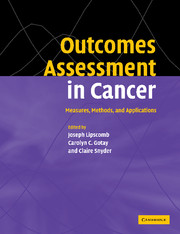Book contents
- Frontmatter
- Contents
- List of contributors
- Acknowledgments
- 1 Introduction to Outcomes Assessment in Cancer
- Health-related quality of life in cancer: general concepts and generic measures
- 2 Definitions and conceptual models of quality of life
- 3 Assessing health status and quality of life of cancer patients: the use of general instruments
- 4 The roles for preference-based measures in support of cancer research and policy
- Assessing health-related quality of life during treatment
- Assessing health-related quality of life across the cancer continuum
- Measuring the experience and needs of cancer patients and caregivers
- Methodological considerations in applications to cancer outcomes research
- Modern psychometric theory in cancer outcomes research
- Assessing the economic impact of cancer
- Research and policy implications
- Invited papers
- Index
- References
4 - The roles for preference-based measures in support of cancer research and policy
Published online by Cambridge University Press: 18 December 2009
- Frontmatter
- Contents
- List of contributors
- Acknowledgments
- 1 Introduction to Outcomes Assessment in Cancer
- Health-related quality of life in cancer: general concepts and generic measures
- 2 Definitions and conceptual models of quality of life
- 3 Assessing health status and quality of life of cancer patients: the use of general instruments
- 4 The roles for preference-based measures in support of cancer research and policy
- Assessing health-related quality of life during treatment
- Assessing health-related quality of life across the cancer continuum
- Measuring the experience and needs of cancer patients and caregivers
- Methodological considerations in applications to cancer outcomes research
- Modern psychometric theory in cancer outcomes research
- Assessing the economic impact of cancer
- Research and policy implications
- Invited papers
- Index
- References
Summary
Introduction
Although not widely used yet in studies of breast, prostate, colorectal, or lung cancer, preference-based outcome measures are starting to play an important role in the assessment of health-related quality of life (HRQOL) in decision analyses about optimal treatment choice and in the economic evaluation of interventions for these cancers.
There is increasing emphasis now on “patient-reported” or “patient-centered” outcome measures, as noted throughout this volume, and a wide range of generic, general cancer, and cancer-site-specific HRQOL instruments are being applied. But virtually all of these are, from the perspective of this chapter, non-preference-based. Whether the instrument in question is single-dimensional (e.g., the Brief Pain Index), multi-dimensional yielding an aggregate score (e.g., FACT-G), or multi-dimensional yielding a profile of scores (e.g., SF-36; see Erickson), the patient's summary score is derived through some form of psychometric scaling process that does not assume, and thus cannot convey, information about the patient's own relative valuation of the health states in question. By contrast, preference-based measures are derived from either direct statements about, or statistical inferences concerning, the relative value the patient places on her current state of health. In this chapter, patient-centered means patient preference-based.
There are two major families of preference-based measures: direct (the patient is queried straightforwardly about how she values the health states at issue) and indirect (the patient received an imputed preference score through a several step attribution process). For reasons that will become clear, the indirect approach is generally referred to now as the “multi-attribute” approach.
- Type
- Chapter
- Information
- Outcomes Assessment in CancerMeasures, Methods and Applications, pp. 69 - 92Publisher: Cambridge University PressPrint publication year: 2004
References
- 1
- Cited by



